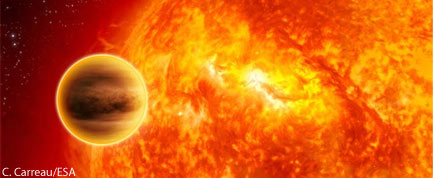Alien Planets Gather Close Around Dying Star

Two distant alien planets around a dying star have been discovered locked in the closest orbital embrace ever seen, a new study has found.
These two gas giant planets are bound by their mutual gravitational attraction, and are closer and tighter than any previously discovered set of planets.
"This is the tightest system that’s ever been discovered, and we’re at a loss to explain why this happened," said Caltech astronomer John Johnson, leader of the new study, in a statement. "This is the latest in a long line of strange discoveries about extrasolar planets, and it shows that exoplanets continuously have this ability to surprise us. Each time we think we can explain them, something else comes along."
The newly discovered pair is orbiting the massive dying star HD 200964, located roughly 223 light-years from Earth.
"A planetary system with such closely spaced giant planets would be destroyed quickly if the planets weren’t doing such a well synchronized dance," said co-researcher Eric Ford of the University of Florida in Gainsville. "This makes it a real puzzle how the planets could have found their rhythm." [Gallery: Strangest Alien Planets]
More close planets
In addition, the team also discovered two more extrasolar planets also locked in a tight embrace around a different star.
Get the world’s most fascinating discoveries delivered straight to your inbox.
Both these planets, and the pair in the first set, are gas giants more massive than Jupiter. Like most exoplanets, they were discovered by measuring the wobble, or Doppler shift, in the light emitted by their parent stars as the planets orbit around them.
Surprisingly, however, the members of each pair are located remarkably close to one another.
For example, the distance between the planets orbiting HD 200964 occasionally is just 0.35 astronomical units (AU) – roughly 33 million miles (53 million km) – comparable to the distance between Earth and Mars.
The planets orbiting the second star — 24 Sextanis located 244 light-years from Earth — are 0.75 AU apart, or about 70 million miles (112 million km). By comparison, Jupiter and Saturn are never less than 330 million miles (531 million km) apart.
And these two pairs of closely orbiting stars may be the tip of the cosmic iceberg. Hundreds more could exist around other massive stars.
"Right now, we're monitoring 450 of these massive stars, and we are finding swarms of planets," Johnson said. "Around these stars, we are seeing three to four times more planets out to a distance of about 3 AU — the distance of our asteroid belt — than we see around main sequence stars."
Main sequence stars are stars in a certain portion of their lifetime where they are fueled by burning hydrogen into helium. The sun is currently in its main sequence phase.
Stellar mass has a huge influence on frequency of planet occurrence, because the amount of raw material available to build planets scales with the mass of the star.
Because of their large masses and close proximity, the exoplanet pairs exert a large gravitational force on each other. The gravitational tug between HD 200964’s two planets, for example, is 3 million times greater than the gravitational force between Earth and Mars, 700 times larger than that between the Earth and the moon, and four times larger than the pull of our sun on the Earth.
And, unlike the gas giants in our own solar system, the new planets are located comparatively close to their stars.
The planets orbiting 24 Sextanis have orbital periods of 455 days (1.25 Earth years) and 910 days (2.5 years), and the companions to HD 200964 periods of 630 days (1.75 years) and 830 days (2.3 years). Jupiter, by contrast, takes just under 12 Earth years to make one pass around the sun.
Alien planet oddballs
The scientists aren't sure how the planets got in these peculiar, carefully balanced configurations. They suspect that they formed at different locations and may have migrated into these positions.
Eventually, perhaps 10 million or 100 million years from now, the stars HD 200964 and 24 Sextanis will become red giants. They will throw off their outer atmospheres, swelling to the point where they could engulf the inner planet of their dancing pair, and will throw off mass, changing the gravitational dynamics of their whole system.
"The planets will then move out, and their orbits will become unstable," Johnson said. “Most likely one of the planets will get flung out of the system completely," and the dance will end.
The scientists report their discovery in a paper accepted for publication in the Astronomical Journal.



